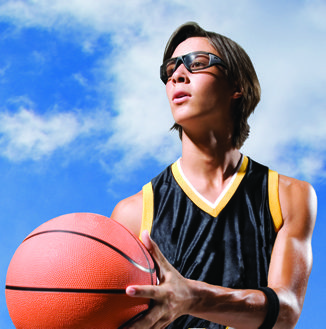Prevent Blindness America Urges Players to Use Proper Eye Protection While Competing in College Basketball Tournament
CHICAGO (March 14, 2013)– In anticipation of the upcoming NCAA Men’s and Women’s Basketball Championship tournaments, Prevent Blindness America is urging players to keep their eyes healthy by wearing the proper eye protection. According to the national non-profit, eye health and safety organization, basketball is the leading cause of sports-related eye injuries among those ages 15 and older.
 In addition, The Coalition to Prevent Sports Eye Injuries reports that one in 10 college basketball players suffer an eye injury each season. Eye injuries can include corneal abrasions, blunt trauma and penetrating injuries, inflamed iris, fracture of the eye socket, swollen or detached retinas, traumatic cataract and blood spilling into the eye’s anterior chamber. Some eye injuries may be serious enough to cause permanent vision loss.
In addition, The Coalition to Prevent Sports Eye Injuries reports that one in 10 college basketball players suffer an eye injury each season. Eye injuries can include corneal abrasions, blunt trauma and penetrating injuries, inflamed iris, fracture of the eye socket, swollen or detached retinas, traumatic cataract and blood spilling into the eye’s anterior chamber. Some eye injuries may be serious enough to cause permanent vision loss.
Wearing the proper eye protection can prevent most eye injuries. Prevent Blindness America provides the following tips on how to purchase the right kind of eye protection for all athletes:
-
- If you wear prescription glasses, ask your eye doctor to fit you for prescription eye protection.
-
- Check the packaging to see if the eye protector you select has been tested for sports use. Also check to see that the eye protector is made of polycarbonate material. Polycarbonate eye protectors are the most impact resistant.
-
- In order to be assured that your eyes are protected, it is important that any eye guard or sports protective eyewear be labeled as ASTM F803 approved. This eyewear is performance tested to give you the highest levels of protection.
-
- Fogging of the lenses can be a problem when you’re active. Some eye protectors are available with anti-fog coating. Others have side vents for additional ventilation. Try on different types to determine which is most comfortable for you.
-
- Sports eye protectors should be padded or cushioned along the brow and bridge of the nose. Padding will prevent the eye protectors from cutting your skin.
-
- Try on the eye protector to determine if it’s the right size. Adjust the strap and make sure it’s not too tight or too loose. If you purchased your eye protectors at an optical store, an optical representative can help you adjust the eye protector for a comfortable fit.
“An eye injury can happen in a split-second, but the effects can last a lifetime,” said Hugh R. Parry, president and CEO of Prevent Blindness America. “We want to advise all those playing any sport anywhere to make sure that eye protection is always part of the uniform.”
For more information on sports eye injury prevention and information on sport-specific eye protection recommendations, please call Prevent Blindness America at (800) 331-2020, or visit preventblindness.org/sports-eye-safety.
Download a copy of the March Madness sports eye safety release.
